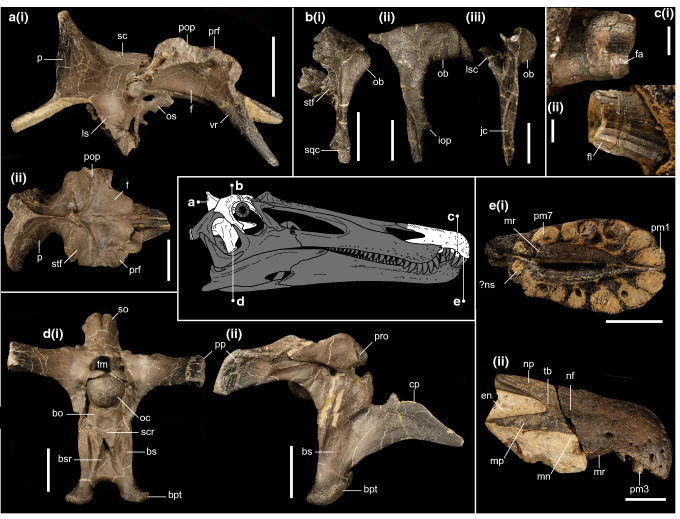Figure 3.
Cranial material of Ceratosuchops inferodios. (a) Holotype skull roof fragment (IWCMS 2014.95.1), in (i) right lateral and (ii) dorsal views; (b) referred right postorbital (IWCMS 2014.95.4), in (i) dorsal, (ii) lateral and (iii) posterior views; (c) close up of holotype in situ Rpm3 (IWCMS 2014.95.5) in (i) labial and (ii) lingual views; (d) holotype basicranium (IWCMS 2014.95.3), in (i) posterior (rearticulated with the supraoccipital + left otoccipital fragment IWCMS 2014.95.2) and (ii) right lateral views; (e) holotype premaxillae (IWCMS 2014.95.5, 2021.30), in (i) ventral and (ii) right lateral views. bo basioccipital, bs basisphenoid, bpt basipterygoid process, bsr basisphenoid recess, cp cultriform process, en external naris, f frontal, fa faceting, fl fluting, fm foramen magnum, iop infraorbital process, jc jugal contact, ls laterosphenoid, lsc laterosphenoid contact, mn maxillary notch, mp maxillary process, mr median ridge, nf narial fossa, np nasal process, ns nasal sinus, ob orbital boss, oc occipital condyle, os orbitosphenoid, p parietal, pop postorbital process, pm(n) premaxillary tooth/alveolus (tooth position), prf prefrontal, pro prootic, sc sagittal crest, scr subcondylar recess, so supraoccipital, sqf squamosal contact, stf supratemporal fossa, tb tuberosity, vp ventral process of the prefrontal. Skull reconstruction credit: Dan Folkes (CC-BY 4.0). Scale bars a–b, d–e: 50 mm; c: 5 mm.

